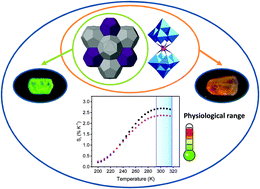Temperature sensors based on europium polyoxometalate and mesoporous terbium metal–organic framework†
Abstract
The first example of ratiometric luminescent thermometers based on lanthanide molecular species encapsulated in a lanthanide metal–organic framework (MOF) is reported. In EuW10@Tb-TATB, the [EuW10O36]9− polyoxometalate (POM) is incorporated into the cavities of the mesoporous terbium MOF Tb-TATB with two different POM loadings (9.1 and 19.5 wt%). Eu3+ and Tb3+ ions of the POM and MOF, respectively, act as dual emitters. Optical measurements evidence efficient Tb3+-to-Eu3+ energy transfer, suggesting that the EuW10 units are close to terbium centers. These observations are supported by computational investigations whereby a favored localisation of the EuW10 POM in the MOF's pores is found close to Tb-centers evidencing hydrogen bond type interactions between terminal oxygen atoms of the POM and Tb-coordinated water molecules. The reported materials act as temperature sensors in the physiological domain, exhibiting high relative thermal sensitivities of 2.68% K−1 and 2.37% K−1 at 300 K for the 9.1 wt% and 19.5 wt% composites, respectively, with a thermal uncertainty of 0.09 K.



 Please wait while we load your content...
Please wait while we load your content...